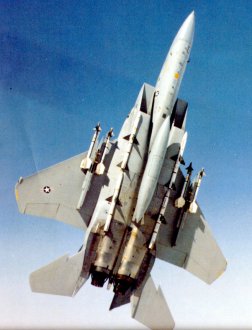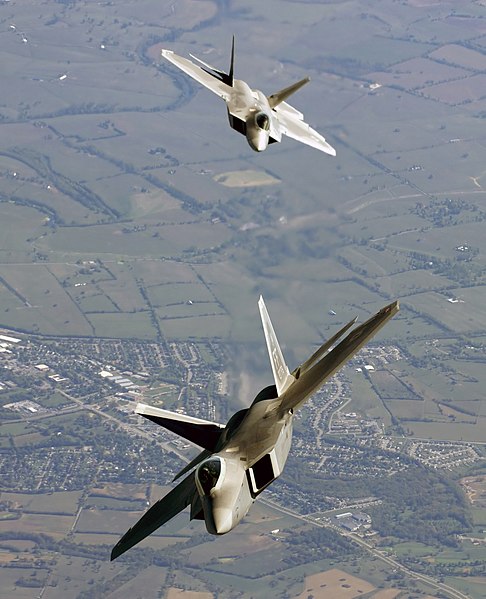A
dogfight or
dog fight is
aerial combat between fighter aircraft. The term originated during World War I when pilots had to switch off their engines to avoid turning into the torque, and then restart them again, which from the ground sounded like dogs barking.
Modern terminology for aerial combat between aircraft is
air-to-air combat and
air combat manoeuvring, or ACM.
World War I

Dogfighting emerged in World War I. Aircraft were initially used as mobile observation vehicles and early pilots gave little thought to aerial combat—enemy pilots at first simply exchanged waves. Intrepid pilots decided to interfere with enemy reconnaissance by improvised means, including throwing bricks,
grenades and sometimes rope, which they hoped would entangle the enemy plane's propeller. This progressed to pilots firing hand-held guns at enemy planes. Once
machine guns were mounted to the plane, either on a flexible mounting or higher on the wings of early
biplanes, the era of air combat began. The Germans acquired an early air superiority due to the invention of synchronization gear in 1915.
During the first part of the war, there was no established tactical doctrine for air-to-air combat. Oswald Boelcke was the first to analyze the tactics of aerial warfare, resulting in a set of rules known as the Dicta Boelcke. Many of Boelcke's concepts, conceived in 1916, are still applicable today, including use of sun and altitude, surprise attack, and turning to meet a threat.
World War II


During the 1930s two different streams of thought about air-to-air combat began to emerge, resulting in two different streams of monoplane fighter dev
elopment. In Japan and Italy especially, there continued to be a strong belief that lightly armed, highly manoeuvrable single seat fighters would still play a primary role in air-to-air combat. Aircraft such as the Nakajima Ki-27 and Nakajima Ki-43 and the Mitsubishi A6M Zero in Japan, and the Fiat G.50 and Macchi C.200 in Italy epitomised a generation of monoplanes designed to this concept.
The other stream of thought, which emerged primarily in Britain, Germany, the Soviet Union and the United States was the belief the high speeds of modern combat aircraft and the g-forces imposed by aerial combat meant that dogfighting in the classic WW I sense would be impossible. Fighters such as the Messerschmitt Bf 109, the Supermarine Spitfire, the Yakovlev Yak-1 and the Curtiss P-40 were all designed for high level speeds and a good rate of climb. Good manoeuvrability was not a primary objective
A pilot who realized that new tactics had to be devised was then-Lieutenant Commander John S. "Jimmy" Thach, commander of Fighting Three in San Diego. He read the early reports coming out of China and wrestled with the problem of his F4F Wildcats being relatively slower and much less manoeuvrable than the Japanese planes. He devised a defensive manoeuvre called the "Thach Weave" by Lt.Cdr James H. Flatley, another fighter tactician and contemporary of Thach. Lt.Cdr Thach reasoned that two planes, a leader and his wingman, could fly about 200 feet apart, and adopt a weaving formation when under attack by Japanese fighters. He later faced the A6M Zero during the Battle of Midway in June 1942 for the acid test of his theory. Although outnumbered, he found that a Zero would lock onto the tail of one of the fighters. In response, the two planes would turn toward each other. When the Zero followed its original target thro
ugh the turn, it would come into a position to be fired on by the target's wingman, and the predator would become the prey. His tactic proved to be effective and was soon adopted by other squadrons. The Thach Weave helped make up for the inferiority of the US planes in technology and numbers, until new aircraft could be brought into service. The usefulness of this strategy survives until today.
Mod ern air combat
ern air combat

Even in the jet age, modern air-to-air combat can develop into dog fights. A fighter can evade a missile by abrupt maximum-performance turns and employing countermeasures—such as chaff and flares—provided he can detect the missile via a radar warning receiver (RWR) or visually. If beyond-visual-range (BVR) missiles can be defeated, pilots can press the attack and very quickly arrive at the within-visual-range (WVR) arena. This will typically result in a high-speed neutral pass (or merge) from which the opposing pilots must decide to turn and continue the fight with his or her opponent or continue straight and 'bug-out'. The turning fight that develops can be commonly called a dog fight, or basic fighter manoeuvring (BFM).
Superiority in a dog fight can depend on a pilot's experience and skill, and the agility of his fighter when flown at minimum air speeds approaching loss of control (causing a danger of stalling); the winner typically plays to the strengths of his own aircraft while forcing his adversary to fly at a design disadvantage. Dogfights are generally contests fought at low airspeeds, while maintaining enough energy for violent acrobatic manoeuvring, as pilots attempt to remain within air speeds with a maximum turn rate and minimum turn radius: the so-called "corner speed" that often lies between 300 and 400 knots, depending on conditions. Therefore a dogfight has nothing to do with supersonic speed, but much to do with the engine power that makes supersonic flight possible. The F-22 Raptor can stand on its steerable nozzles at less than 100 knots airspeed, yet quickly manoeuvre to bring its M61 Vulcan cannon to bear on a nearby evasive target, while an F-15 Eagle is more likely to use its thrust to maintain its relatively high corner speed, working to counter the drag caused by tight turns.
The continued importance of maintaining dogfighting proficiency was demonstrated during the Vietnam War. American pilots flew aircraft such as the F-4 Phantom II, equipped with long-range AIM-7 Sparrow missiles, and AIM-9 Sidewinder missiles. However, air crews were required not to fire any missiles without having visually identified the target first, to make absolutely sure they were not an ally, thus losing this technological advantage. The AIM-7 missile was also not very reliable, making heavy use of delicate components such as vacuum tubes—which had to endure the SE Asia climate, carrier takeoffs, and high-stress manoeuvres. Also, they had semi-active radar homing, meaning that they used the carrier plane's radar signals to home in on the target. The missiles themselves did not have a radar system, but "listened" to the pings of the attacker's radar and used the reflection of the prey aircraft to home in on it. AIM-9 missile were heat-seeking fire-and-forget missiles, meaning that once they had a lock on a heat source, they would attempt to hit it. They were only useful in short range, and in many cases failed, due to a number of factors, including delicate instruments and false heat sources (such as the sun). Additionally, early versions of the F-4 (prior to the E model) relied solely on missiles, having no guns nor lead-computing Gyro gunsight, and were therefore very vulnerable in the gun-range combat that could ensue.
Lightweight, short-endurance, point-defense fighters such as the MiG-17 and MiG-21 are typically far more agile than heavy, long-range, fighter-bombers (see the F-105 Thunderchief). Still, using superior tactics, the AIM-9 Sidewinder short-range missiles, and cannon fire, American pilots were able to gain significant victories in the air over North Vietnam, especially after the establishment in 1969, of the United States Navy Fighter Weapons School (TOPGUN) to restore dogfighting ability to its pilots. At this school, pilots learned to exchange airspeed for altitude, using maneuvers like the Immelman turn and the Split-S, and to master tricks that put him behind an enemy fighter, where the enemy is vulnerable to heat-seeking Sidewinder missiles.
Referring back the previous section, which focused on tactics developed during World War II, the North Vietnamese MiG-17 resorted to use of the Lufbery maneuver on occasion when cornered by faster F-4 Phantom fighters. Whereas the Thach Weave is used as aircraft move towards a point in space, the Lufbery is employed over a fixed point.
With modern air-to-air AMRAAM guided missiles greatly extending the general engagement range of jet fighters, some experts hypothesize that dogfighting may be headed toward extinction, but others cite the occurrences in Vietnam as evidence otherwise. However, it is worth noting that there have been a great number of Beyond-Visual-Range (BVR) kills occurring during and after the Persian Gulf War. This was due to the improved reliability of BVR missiles, radars, and most importantly, the integration of C3I assets, such as AWACS aircraft, into the realm of aerial warfare. This provided Coalition forces with a superior picture of the battlefield, and in conjunction with airspace management allowed utilization of BVR weaponry.
Despite this, the improvement of all-aspect IR, missiles coupled with helmet-mounted sights, has reduced the necessity of tail-chase attacks. In addition, Russian development of tail-mounted radar and rear-firing missiles has reduced Russian planes' vulnerability to tail-chase attacks.
Yet because this feature is only present on the most modern jets, and missiles are a finite resource, the US Navy (TOPGUN) and the US Air Force (Red Flag) continue to teach postgraduate-level classes in air-combat-manoeuvering engagements. Russian aircraft manufacturers heavily emphasize superagility and dogfight capabilities in fighter design, with aircraft such as the Su-37 or the Su-30MKI demonstrating advanced thrust vectoring systems to achieve these goals, pushing the aircraft to its limits to give it an advantage in combat. USAF fighters, such as the F-15 and F-16, tend to favor higher speeds, because of their emphasis on high power-to-weight ratio and low wing-loading; although the F-22 has superagility with its own vectored thrust
Labels: Dogfight, WHAT IS
Post a Comment